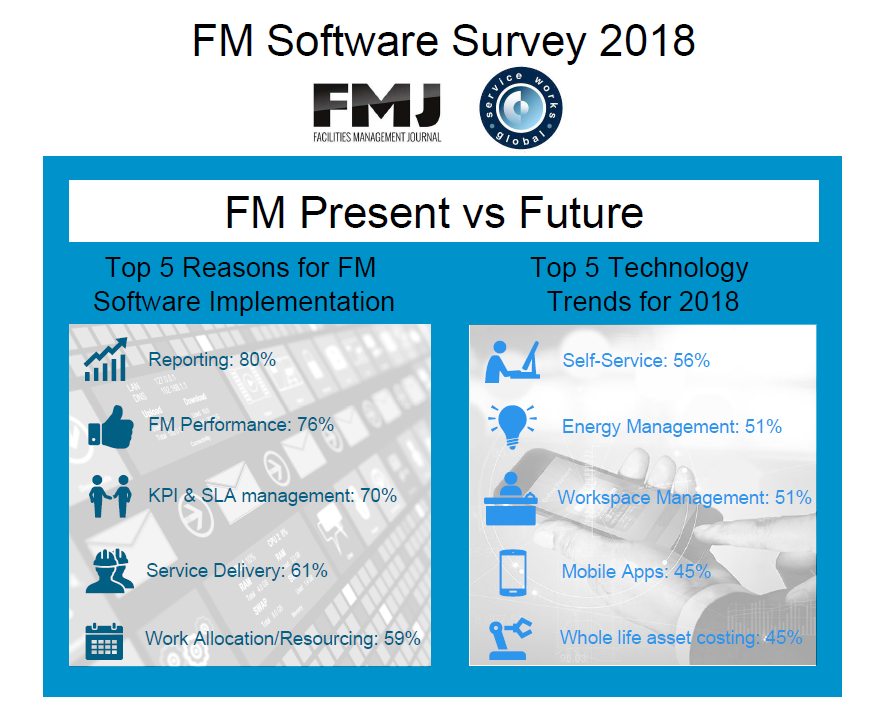Ahead of a full report on our FM Software Survey 2018 published in FMJ’s next edition, in this blog we reveal the top five technology trends that FM professionals are preparing for this year and beyond.
FM Self-Service
Voted as a top technology trend this year and also in Service Works’ previous two surveys, self-service is proven to improve efficiency of the FM team. With the help desk as the first point of contact there is pressure to answer each call and take down information without error. The way to alleviate strain is by offering a self-service tool for building users and site operatives. As well as allowing the work to be logged and prioritised, the CAFM system can automate emails to the users to confirm receipt of requests as well as work completion – eliminating the need for progress reports and creating an easy customer service win. For more information request our complimentary white paper here.
Workspace Management
At joint second with 51% of votes, space management is a growing trend across the UK. As discussed in our blog last month, noise in open plan offices and the cost of rent are national bugbears. Furthermore, the value of a positive workspace in improving productivity and helping recruitment is growing, and with it, the status of the FM profession. As of 12 November 2018, the British Institute of Facilities Management will change its name to the Institute of Workplace and Facilities Management to reflect this, defining workplace as a combination of space, culture and technology. For more detail on space management, request our complimentary white paper here.
Energy Management
51% feel energy management is of key importance, in line with a global trend towards sustainability. CAFM software can track energy usage and costs for a facility, allowing users to identify and take action against areas of energy waste. Not only does this limit pollutants and their damage to our planet, it also saves the company money. Read more about the importance of FM’s energy management through technology in our blog The Future of Climate Change and the Impact of FM.
Mobile Apps
Like self-service, the use of mobile in FM has been consistently growing over the last few years. 45% of those surveyed by SWG see this as a trend, although wearable devices such as smart watches, smart glasses of fitness trackers are not yet on the horizon for FM. While mobiles are now almost an extension of the human body with 78% of adults owing a smartphone and 40% checking their phone within the first five minutes of waking, according to the same report only 20% have invested in a smart watch. With the pressure of IoT becoming more mainstream and the possibility of being left behind, FMs are faced with the unenviable task of deciding which technologies will benefit them most.
Whole Life Asset Costing
Unplanned and unexpected maintenance costs are a drain to profitability, which may cost half of all money spent on existing buildings. QFM’s asset lifecycle software is completely integrated into our CAFM software, and as such is a valuable tool in optimising asset life and reducing costs. By gathering extensive asset data, QFM can calculate both one off costs such as acquisition or installation, as well as expenditure for routine maintenance, such as the estimated cost of labour, parts and travel. The software automatically calculates predicted maintenance costs over its lifetime, or, for example, a service provider’s contract. FMs can then easily see the information required to make the most effective maintenance plans for each asset, make informed decisions on servicing and replacement and ensure assets are both available and running as the lowest cost possible.
If you would like to receive a copy of the FM Software Survey 2018 from Service Works Global and FMJ, please email info@swg.com.
To receive Service Works’ weekly blog straight to your inbox, sign up to our email service: https://www.swg.com/blog-signup/


 Australia
Australia



